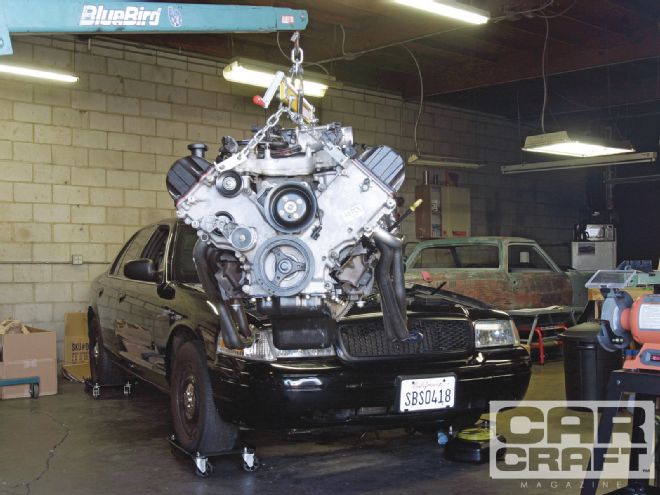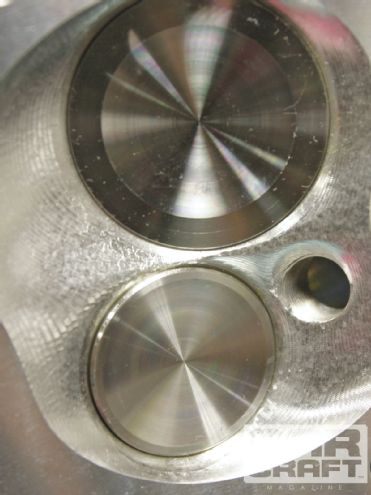
At the risk of losing credibility with our readers (assuming I had any to begin with!), I must admit to never having built an engine before. I’ve done general maintenance, bodywork, welding, complete paintjobs, and even rebuilt a couple of automatic transmissions, but I’ve never taken an engine apart and put it back together—until now. People I’ve revealed this to usually have the same reaction: Couldn’t you have chosen an easier engine to build than the 4.6? My response is always the same (and I hope I don’t sound smug when I say it): Building this engine wasn’t that hard.
I mention this potentially embarrassing truth not as a means of publicly patting myself on the back but rather to inspire our readers. If I can put together an overhead cam 4.6L Ford engine, so can you. To my relief, it started and ran once I got it back in the car. It runs even better now with at least 4,000 miles of daily driving and almost 30 full power pulls on Westech’s chassis dyno. No oil loss, no scary sounds, and best of all, it makes nearly 70 more horsepower and 50 more lb-ft of torque than before, thanks to Trick Flow Specialties Top End Kit for 2V Modular Ford engines.
Don’t be fooled by this car’s two extra doors; this same build will work for any SOHC 4.6 or 5.4L Ford engine currently running in millions of cars and trucks—SN-95 Mustangs, Thunderbirds and Cougars, Town Cars, hell, even F-150 and Econoline van owners can do this job and reap the benefits of Trick Flow’s 4.6 Twisted Wedge Top End Kit.
Mod Motor Cam Timing
I’ve come across a lot of rumors floating around online about mod motor cams being installed as many as 4 degrees advanced or retarded from the factory. Wanting to verify this, I checked my engine’s cam timing before removing the cylinder heads. We won’t document the entire cam timing test process here, as we’ve done about half a million cam timing articles in the past 58 years. The mod motor’s overhead cam arrangement only adds a slight twist to the process in this boilerplate article.
Cylinder Head Flow Chart
I brought the stock heads and the new Trick Flow heads to Westech for flow bench testing. The difference is dramatic. There is a lot of potential in these Trick Flow castings.
Stock:
Valve Opening Intake CFM Exhaust CFM 0.050 27 22 0.100 51 50 0.200 96 86 0.300 133 111 0.400 156 124 0.500 171 131 0.600 177 135
Trick Flow:
Valve Opening Intake CFM Exhaust CFM 0.050 26 23 0.100 54 50 0.200 124 93 0.300 173 129 0.400 210 155 0.500 232 165 0.600 239 170
*Cylinder heads tested at Westech Performance’s SuperFlow 300 flow bench with a 3.580 bore adapter. Stock 4.6 bore is 3.552 inches.
On the Dyno
The engine fired on the second crank and ran surprisingly well. After fixing the previously mentioned oil leaks from the gallery plugs in the cylinder heads (and fixing an unrelated wiring nightmare under the dash), my car felt really strong running on Blue Oval Chips’ programming for the Mercury Marauder MAF installed in our June ’11 issue. However, Trick Flow recommends reprogramming the ECM after installing its Top End Kit, so I spent the better part of a day on Westech’s chassis dyno, as Ernie Mena fine-tuned the air/fuel ratio and timing. Tuning Ford ECMs requires some sort of handheld programmer that goes between the tuning shop’s laptop and the ECM. Ernie used the SCT X3 Power Flash programmer I bought from Blue Oval Chips. As a result, my car is now making 70 more horsepower and nearly 50 more lb-ft of torque. The torque band is much flatter than stock, as well, making about 300 lb-ft from 3,500 rpm all the way to 5,000 rpm. The car feels much more powerful and a lot more fun to drive. We’ll have some dragstrip numbers to back up these horsepower figures soon.
Where’d That Power Come From?
Stock versus Trick Flow Heads
Stock NPI (92-99) Heads Stock PI (99-Present)Heads TFS Twisted Wedge Intake Runner 146 cc 159 cc 185 cc Intake Valve Diameter 1.752 inches 1.752 inches 1.840 inches Exhaust Runner 93 cc Exhaust Valve Diameter 1.339 inches 1.417 inches 1.450 inches Combustion Chamber 52 cc 44 cc 38 cc Compression ratio (stock pistons, rods cylinder bore, and deck height) 9.3:1(with 10.5cc piston dish) 9.4:1(with 15.8cc piston dish) 10.1:1(with 15.8cc piston dish) Cam Specs 204/208 duration at 0.050 lift/0.480 valve lift 200/208 duration, 0.505/0.531 valve lift, 115 LSA 228/230 duration, 0.550 valve lift, 112 LSA
The secret to our 4.6’s newly found power is a collaboration of a better combustion chamber design, bigger ports, slightly larger valves, and Trick Flow’s canted valve arrangement. Changing the angle of the intake valve provides a better path into the cylinders. It also eliminates piston-to-valve clearance problems very common to SOHC 4.6 engines—you can’t advance the cam too far or run intake lift numbers more than about 0.525 inch without notching the pistons. With its valve arrangement, Trick Flow says lift of up to 0.600 inch is safe. Every engine builder we’ve checked with says Trick Flow’s heads—with CNC-shaped chambers and as-cast intake and exhaust runners—will outflow any ported factory cylinder head, and our gains of 70 hp to the rear wheels is right inline with what other Trick Flow customers are seeing. While we’re still breathing through the car’s stock intake and tailpipes, we know there is more potential in these heads, especially at higher engine speeds. We’re looking at intake combinations and possibly a power-adder to see how much more we can wring out of these things. Note in the chart above that the best naturally aspirated combination may be an early non-power- improved block and Trick Flow’s 38cc chamber heads. If you want more compression, bolt these heads on a four-valve block, which comes with flat-top pistons and will net a compression ratio of nearly 12:1. For guys who love boost, Trick Flow also sells a version of these cylinder heads with 44cc combustion chambers. END

Parts List
Description PN Source Price Clean block and install freeze plugs N/A Hi-Tek $50.00 Trick Flow 2V Modular Top End Kit TFS-K519-390-375 Summit Racing 2,899.95 ARP main bearing cam studs 156-5401 ARP 106.95 King main bearings KGB-MB5353SI Summit Racing 50.95 King connecting rod bearings KGB-CR868SI Summit Racing 39.95 Cloyes timing chain tensioner, right 9-5433 Rock Auto 33.79 Cloyes timing chain tensioner, left 9-5432 Rock Auto 32.79 Fel-Pro timing cover gasket set TCS45869-1 Rock Auto 16.64 Fel-Pro oil filter adapter gasket 230 70801 Rock Auto 7.59 Fel-Pro front crank seal 230 TCS46114 Rock Auto 9.31 Cloyes tensioner arm, right 95340 Rock Auto 17.51 Cloyes tensioner arm, left 95341 Rock Auto 18.81 Cloyes timing chain guide, right 95428 Rock Auto 18.81 Cloyes timing chain guide, left 95429 Rock Auto 19.17 Fel-Pro Oil pan gasket OS30725R Rock Auto 22.79 Fel-Pro valve cover gaskets VS50564R Rock Auto 29.79 Comp adjustable cam gear set 10246SET Comp 248.95 Connecting rod bolts (4.95 each) F3LY-6214-A South Bay Ford 79.20 Rear main seal F4AZ-6701-A South Bay Ford 25.57 Piston pin retainers(sold in sets of 4) F6AZ-6140-AA South Bay Ford 37.84 Stainless Works headers and catalytic converters CRVIC03HDRCAT Stainless Works 1,590.00 Spark plugs NGK3403 B&C Auto Parts 27.60 TOTAL $5,383.96
Tool List
Description PN Source Price Ford V8 cam holding tool OTC-6498 Summit Racing $119.95 Cam degree supplement kit TFS-90100 Summit Racing 39.95 Ford rear crank seal installer tool OTC-7786 Summit Racing 109.95 Harmonic balancer installer OTC-6505 Summit Racing 119.95 Cylinder leakdown tester OTC-5609 Summit Racing 99.95 Piston ring installer and compressor tool CMB-17-0000 Summit Racing 34.85 Proform Parts universal degree wheel kit PRO-66787 Summit Racing 89.95 TOTAL $614.55